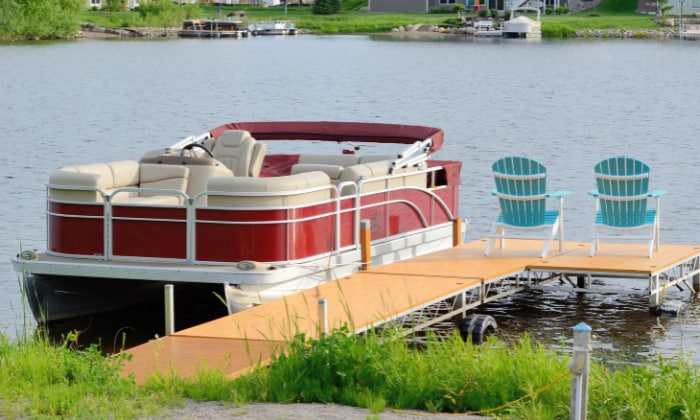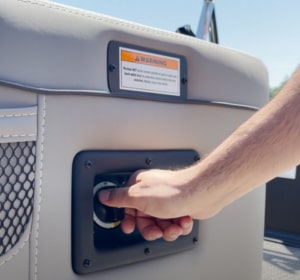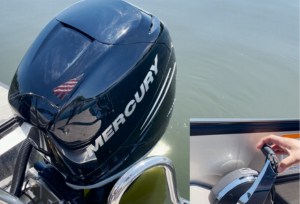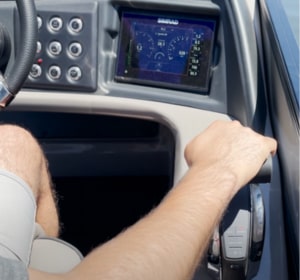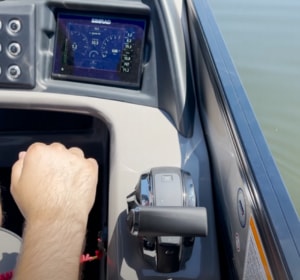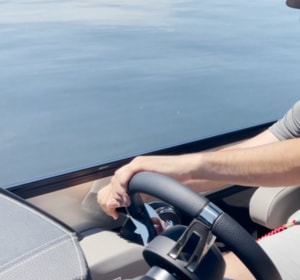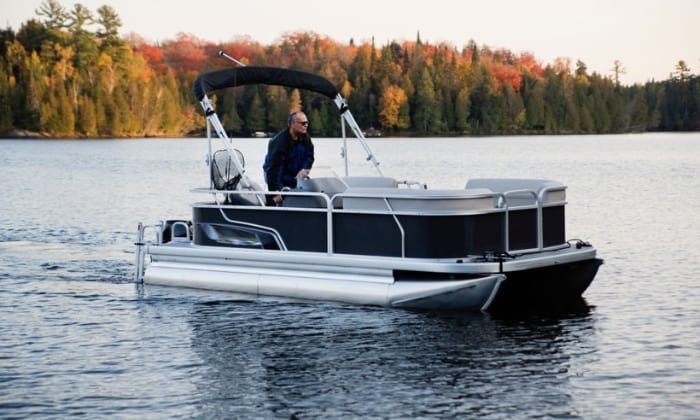Although pontoon boats are some of the best watercraft for beginners, learning how to drive a pontoon boat still requires a stepwise approach. Greenhorn boaters must not only master how to operate a pontoon boat but also take to heart boating safety regulations.
You have two options. First, take a professional pontoon boat driving course and pay a handsome fee. Second, continue reading this how-to beginner’s guide on operating a pontoon boat for different activities.
Most novice boaters pick the second route. And if you’re like them, we can start with your crash course.
Table of Contents
Step-by-Step to Drive a Pontoon Boat
What to prepare
Piloting a pontoon boat starts with pre-boating safety checks, as we would with our cars before we hit the road.
- Please read your pontoon boat manual and familiarize yourself with the features, especially the pontoon boat controls.
- Ensure everyone aboard the pontoon boat wears a USCG-approved (and age-appropriate) life jacket or personal flotation device. A throwable flotation device can also be handy in man-overboard situations.
- Check the pontoon boat’s radio to ensure you can call for help in an emergency. Charge your mobile phone as a backup.
- Assess the fuel level. You don’t want to get stranded in the middle of a lake with your pontoon boat.
- Look at everything on the pontoon boat (i.e., coolers, fishing gear, water sports paraphernalia, and other items) and secure loose items. You don’t want these objects to fall, especially in rough water.
You’re ready to learn the basics of pontoon boat operation after observing the few preliminary safety precautions.
Step 1. Power on the pontoon boat’s motor.
Learning how to start a pontoon boat isn’t different from cranking a car engine. However, manufacturers vary in engine start mechanisms. Some use a dial ignition system, while others employ a push-button technology or a simple key-twist platform.
- Read the manual for the correct procedure for starting the pontoon boat.
- Turn on the watercraft’s engine according to directions.
- Take your position on the captain’s chair.
- Attach the red emergency stop lanyard to your life vest or clothing.
- Ensure the emergency stop switch is in the “RUN” position.
- Leave the pontoon boat’s engine running for one to five minutes or according to the manufacturer’s idling guidelines. This step is crucial to warm the motor before you take the pontoon boat out.
Step 2. Adjust the pontoon boat motor’s trim.
It’s not challenging to learn how to drive a pontoon boat. However, some beginners forget this second step. Trimming the watercraft to the correct settings ensures better fuel economy and a more comfortable ride. It dictates the motor’s depth relative to the water surface.
- Check the pontoon boat’s throttle controls for a “Trim” button. Alternatively, read the manual about where to find this feature in the watercraft.
- Examine the “trim” button for different settings. Set the trim to the recommended level.
- Ask someone to check the pontoon boat’s motor. It should only touch the water and not be fully submerged.
Step 3. Prepare to leave the slip.
One of the best pontoon driving tips we could give is to always be vigilant. Leaving a boat slip or the dock is like backing up from your garage. Examine your immediate surroundings, especially for other boaters and potential obstacles.
- Plan how to steer the pontoon boat out of its “parking” space. This step might be tricky for the first time, but it can become second nature as you progress in your pontoon boat driving.
- Ensure everyone is in their seats, considering a balanced weight distribution.
- Ask an assistant to remove the rope or cable securing the pontoon boat to the dock. This step is crucial because you’ll want to remain in control if something untoward occurs.
Step 4. Back up the pontoon boat
Like backing up a car from the garage and into the street, reversing a pontoon boat can be nerve-wracking for first-timers. You’ll feel more confident with the following steps, which are so easy you’ll never ask, “Is it hard to drive a pontoon boat?” ever again.
- Grab the throttle control and gently engage the gear into Reverse. It’s okay if you’ll go at a snail’s pace at first. You’ll eventually learn the reverse throttling sweet spot.
- Ask your assistant to watch the rear for potential obstacles, including swimmers.
- Gently rotate the steering wheel as you would with a car. That’s how you navigate a pontoon boat safely out of the docks.
- Check the motor and adjust the trim as needed.
Step 5. Learn how to maneuver the pontoon boat.
Steering a pontoon boat isn’t different from a car. Unfortunately, there are no concrete roads to ensure you turn the watercraft on a dime. Hence, it’s not uncommon to overshoot your intended turning point when driving a pontoon boat.
- Practice using the throttle in changing directions to avoid overshooting a turning point objective.
- Please avoid making sharp and sudden turns to ensure passenger safety.
- Always position the pontoon boat downwind to make steering more manageable.
- Reduce the pontoon boat’s speed if you must turn against the wind.
Step 6. Practice cruising and stopping.
Cruising on a lake is ideal because the water is calmer than off the coast. We recommend easing up on the throttle if this is your first time. You can always crank up the pontoon boat’s speed after mastery of the essentials.
- Most pontoon boaters recommend maintaining the engine speed at 4,000 to 4,500 RPM. First-time pontoon operators might want to use a lower setting.
- Learn how to stop the pontoon boat by controlling the throttle and putting it into Reverse. Note that engaging the Reverse from Neutral will back up the pontoon boat.
- Practice trimming the pontoon boat to achieve the desired cruising effects. The bow should not be above water, as it means you have the trim too high.
Step 7. Practice docking the pontoon boat.
We love to anchor a pontoon boat almost anywhere in a body of water. However, you’ll eventually want to steer it back to the docks. Pontoon boat docking is as essential as maneuvering, cruising, and stopping such a watercraft.
- Choose a “parking space” on the dock to secure the pontoon boat, allowing you to make the necessary fender adjustment.
- Remove objects and pontoon boat components obstructing your view of the dock.
- Approach the dock as slowly as possible, using the throttles to steer the boat into place.
- Engage the engine into Reverse when the boat is about ten feet from the dock. The pontoon boat’s momentum will bring it home.
- Secure the lines.
Here’s a video worth watching.
Safety Tips for Driving a Pontoon Boat
Although driving a pontoon boat is easier than piloting a sailboat, you must still observe safe boating practices. You can consider the following.
Boating regulations and speed limits
- Study Federal regulations, including Inland Water Rules.
- Check local laws regarding driving a pontoon boat because regulations vary across states.
- Although most pontoon boats don’t exceed 30 MPH or 26 knots, operators must observe locally-enforced speed limits.
- Ensure compliance with pontoon boat operating rules, including the requirements for fire extinguishers and personal flotation devices.
- Learn the different sound and visual signals for communicating with other pontoon boaters and operators of other watercraft.
- Observe different rules when using a pontoon boat for water sports, being careful in towing a tube or wakeboard through wake.
Advanced pontoon boat techniques
- Please practice the basics of operating a pontoon boat before learning more advanced pontoon boat driving techniques. Mastery of the fundamentals is necessary for higher skills.
- Take professionally-guided pontoon boat driving lessons to learn the tricks of the trade. It might be costly, but the benefits outweigh monetary concerns.
FAQs
Do you need a license to drive a pontoon boat?
Yes, operators must have a “license” to pilot a pontoon boat. Some states require a state-approved boating safety education certificate or card, while others might use an equivalent proof of safe boating operation capability.
Is it easy to drive a pontoon boat? How does it compare to driving other boats?
Yes, driving a pontoon boat is less nerve-wracking than piloting a sailboat. Although it’s not as agile as ski boats or wakeboarding boats, pontoon boats give the sensation of driving a car.
Sailboats are tricky because they are always at risk of tipping over. You’ll never have such an issue with a pontoon boat. Unfortunately, stability undermines speed and agility. Pontoon boats cannot run fast or make sharp turns.
Tips for docking a pontoon boat in a tight slip
You can observe the following tips for docking a pontoon boat in tight spaces, including boat slips.
- Learn how to “read” the wind and water current because a sudden gust can scrape or damage the pontoon boat’s sides on the tight slip.
- Choose a relative bearing or reference point and focus on it. It will give you an idea of the pontoon boat’s movements relative to the fixed point.
- Maneuver the pontoon boat at a 45-degree angle to the slip’s sides, facing the current or wind. Natural forces will help you steer the watercraft into the correct position.
Conclusion
Learning how to drive a pontoon boat might not be as straightforward as taking a car for a spin. However, it’s less nerve-wracking than piloting a sailboat or steering an agile ski boat.
The steps we outlined in this guide are only the basics. We recommend practicing them until you can complete the tasks – from pre-boating checks to docking – without feeling rattled. Mastery will open doors to other exciting pontoon boat-driving tricks.
Read more: Steps to launch a pontoon boat by yourself

Ten years of enjoying countless trips on boats never made me love them any less! So I am here to put all those experiences into good use for other boaters who want to have a safe and fun trip with their friends and families.


